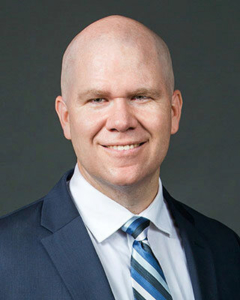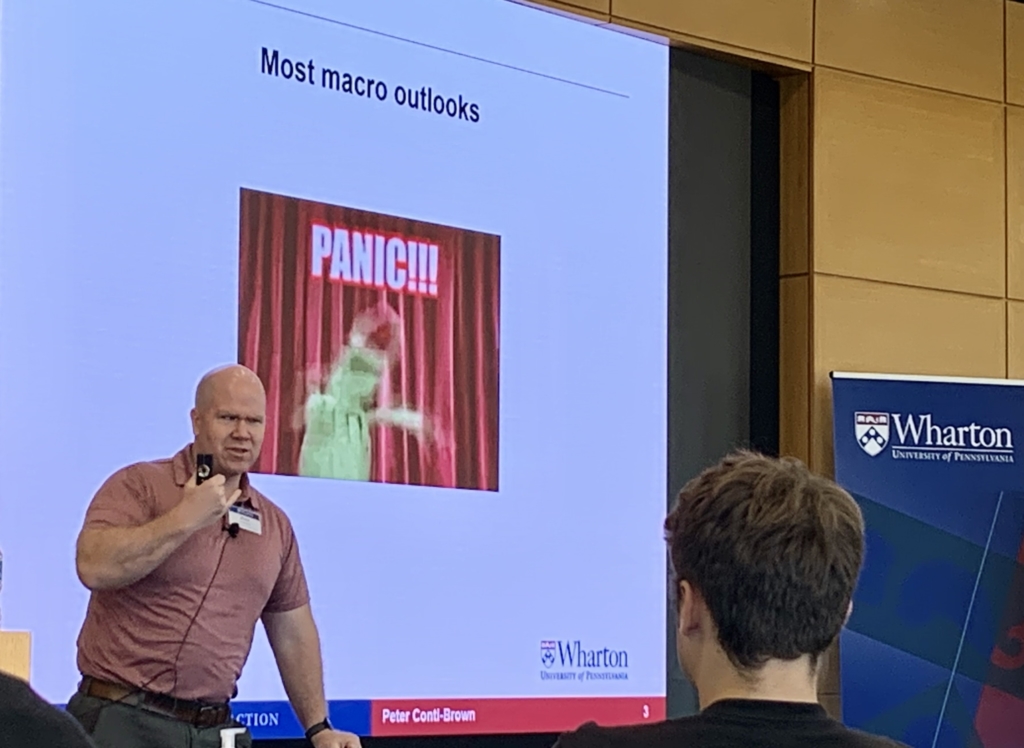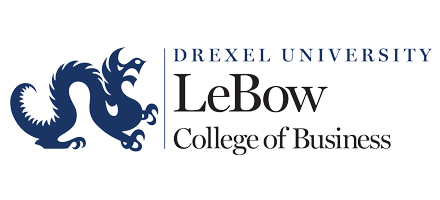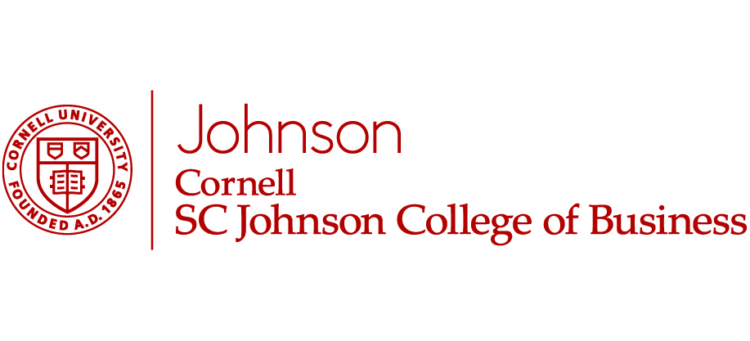
When it comes to recession, are you a panicked Kermit, or a nervous Kermit?
As Peter Conti-Brown sees it, recession soothsayers these days can be categorized with one of two popular Kermit the Frog memes: There’s Panic!!! Kermit – arms flailing, mouth open, screaming upward into the void. That Kermit describes most macroeconomic forecasters right now.
Then, there’s nervous Kermit – staring out from the darkness, clutching his little froggy arm while nibbling his little froggy fingers. Not panicked per se but, you know, watchful.
“I’m not Kermit the screamer, I’m Kermit the nail biter,” said Conti-Brown, associate professor of financial regulation at The Wharton School, “because what’s happening today is extraordinarily uncertain.”
KERMIT THE SCREAMER, A HISTORY
Conti-Brown – who is also an associate professor of legal studies and business ethics at Wharton, and who researches central banking and financial regulation – flashed the two Kermits before a room full of reporters last week during his talk at the Wharton Seminars for Business Journalists. In a presentation covering central banking and financial regulation, the financial historian reasoned that recession right now is largely in the eye of the beholder.
“The macro panic follows the Republican messaging that says we definitely are in a recession, while the Democratic messaging says things are looking very, very good. Who’s right? Well, it’s hard to say,” Conti-Brown said.
So, why are most macroeconomists in Kermit panic mode right now?

Peter Conti-Brown
To get the full context, you have to go back to early 2020 when central banks and governments around the world took a series of “extraordinarily aggressive” actions to curb the financial effects of the COVID-19 pandemic. Stimulus packages – including, in the United States, two from the Trump administration and two from Biden’s – and other maneuvers put a bottom onto what looked like a pandemic freefall. What threatened to become a financial crisis much worse than 2008 turned into, more or less, a weeks-long blip, Conti-Brown says.
“When we think of 2020, many of us think about George Floyd and about the presidential election, but we also should think about the fact that it was the year of the Federal Reserve,” Conti-Brown says. “This was a time when central bankers were taking their bows. In a time when election denialism was running rampant, and there were all these questions about politics, we had the sense that the people who behaved the best were the central bankers.”
AN INFLATIONARY ‘BELCH’
Then came 2021. The year of empty store shelves and viral videos of shoppers fighting over the last package of toilet paper. China’s zero COVID policy led to constant factory shutdowns which led to many fewer toilet paper rolls and computer chips for cars. That was a supply shock, and central bankers can’t call China to get more supply, Conti-Brown says.
So, inflation started to creep up to levels we hadn’t seen in many years. Meanwhile, all those fiscal stimulus packages had created large savings cushions for middle and upper class savers. The Fed saw little reason to step in.
“The word of the day was ‘transitory.’ Some people thought of this as an inflation hiccup and it was all supply driven. But, it turned out that it wasn’t an inflationary hiccup, it was more like an inflationary belch. Like one of those really disgusting belches from a teenager that lasts for a very long time,” Conti-Brown said.
“So the word of the day became ‘soft landing.’”
DEMAND SHOCK OR SUPPLY SHOCK?
When central bankers see inflation, they don’t immediately see it as a central bank problem. They first will ask whether it’s coming from a demand shock – too much money (think all those stimulus checks) chasing too few goods and services – or a supply shock – when an event suddenly changes the supply of a product leading to an unforeseen change in price (think about filling up that gas tank anytime in the six months). There’s nothing a central bank can do about supply shocks.
By summer 2021, the Fed did want to slow inflation, but didn’t want to cause a recession – and it didn’t believe inflation would get much worse.
Enter February 2022. When Russia invaded Ukraine, it triggered an energy crisis in Europe and food shortages around the world.
“The major question for a central banker is is it a supply shock, or is it a demand shock? And no one has the definitive answer. In a supply shock, the central banker covers her eyes and plugs her ears and says, ‘I was hired not to be political.’” Conti-Brown said.
“When it’s a demand shock, the central banker stands up, salutes, and says, ‘Let’s cause some pain so that we can make sure there is no inflation.’ And that’s why the macro outlook today is more one of panic.”
ARE WE IN A RECESSION?

Financial historian Peter Conti-Brown of Wharton explains why most macroeconomists believe the U.S. is now in the middle of a recession, and why he is more reluctant to say so.
The biggest tool the Fed has when trying to curb inflation is to raise interest rates. This makes it more expensive for banks to borrow money which trickles down to businesses and households, effectively slowing consumer demand. The Fed has raised interest rates five times this year alone, and the last three have been by .75 percentage points. It is now expected to raise interest rates by another .75% at its November meeting, meaning the aggressive moves it made earlier this year have become policy status quo, Conti-Brown said. He thinks we are already probably starting to disinflate, but the lag between monetary policy and inflation make it harder to detect. But, it’s a clear signal that the Fed is worried about inflation and is willing to inflict pain upon the economy in order to dampen it.
So, where is Conti-Brown in his recession outlook? Is a recession unlikely, coming, or already here? He presented a six-point recession indicator list often used to predict, or detect, recessions. (‘Yes’ means the indicator for recession has been met, ‘no’ means it hasn’t.)
- Yes – Have there been two consecutive quarters of negative GDP growth?
- Yes – Are we seeing an inverted yield curve? (This occurs when long-term interest rates are less than short-term interest rates so that the yield decreases the further away it is from maturity. This has been a reliable indicator of recession in the past.)
- No – Have we met the Sahm Rule? (This is when the three-month moving average of national unemployment rises by 0.5 percentage points or more relative to its low over the previous 12 months.)
- Yes – Drop in real income adjusted for inflation?
- Uncertain – Drop in industrial production? The data here is ambiguous, but looks to be holding steady.
- No – Drop in retail? People are still shopping, perhaps still buoyed by the stimulus packages that boosted middle and upper class savings accounts.
That’s three recession indicators met, two not met, and one where the data is still coming in. Not an official recession just yet, but there’s trouble on the horizon. It’s why Conti-Brown’s Kermit is nervously biting its nails instead of flailing his arms overhead.
WHAT DOES A RECESSION MEAN?
One indicator to watch in the coming months: Unemployment. According to Federal Reserve Bank forecasts from September 2022, the Fed anticipates unemployment to rise from a projected median of 3.8% to 4.4% in 2023, which would mean a Sahm’s Rule recession.
“I think the probability – and the Fed thinks this too – that we do have a recession by the end of 2023 is nearly 100%,” Conti-Brown says.
The Fed’s aggressive rate hikes in the last three cycles (four if predictions for its November meeting come to pass) are likely to raise unemployment in the United States, which has so far had an impressive upswing since the lows of the pandemic.
“This is the great tragedy of a highly unequal society. Even if we climb to 4.4% unemployment (from about 3.5% today) – that’s phenomenal. That’s fantastic. But what about that 1% of people who slide into unemployment? That is devastating to individuals, families, households, and communities that are most exposed to this,” Conti-Brown says.
Housing will throw another wrench into the cogs for individual job seekers. Over the last year, average mortgage rates have increased 3% to about 7% – equivalent to about a 40% increase in housing prices. Refinancing has fallen 90% in that period while originations have dropped by 38%. “That is catastrophic,” Conti-Brown says. For homeowners facing job uncertainty, it greatly impacts the ability to sell your house and move for another opportunity.
“I’m not exactly sure what among its bad options the Fed should pursue,” Conti-Brown said. “I am telling you this, though: Recognize that the value judgments the Fed has been asked to make and is making are extraordinary. There will be real misery here. It is connected already to the 2022 election, and I think that this is going to be the banner story in the 2024 presidential election.”
DON’T MISS: ECONOMY’S IMPACT ON MBA APPLICATIONS: 4 DEANS, 4 VIEWS AND WHY NOW MAY BE THE BEST TIME FOR U.S. STUDENTS TO GET AN MBA IN THE UK




